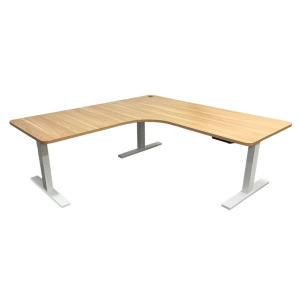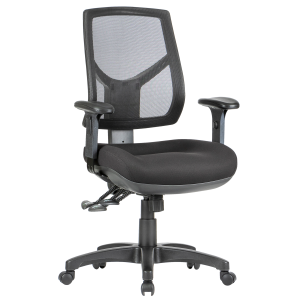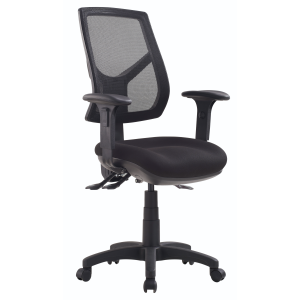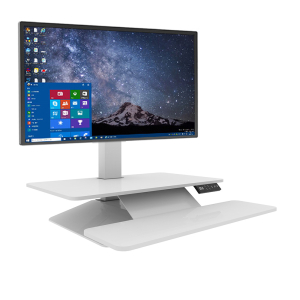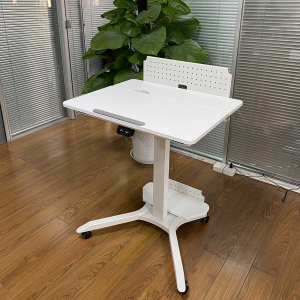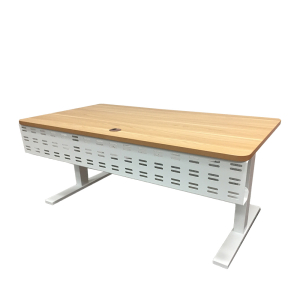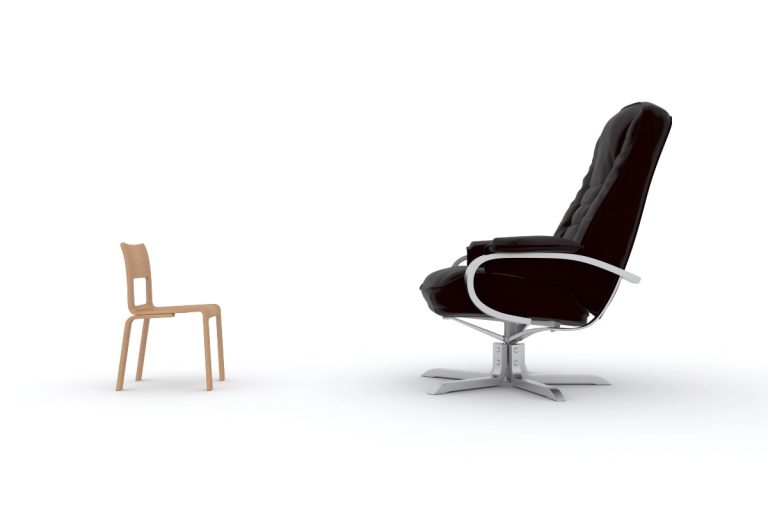How Desk Height Affects Your Posture, Health & Productivity
Did you know that desk height can have a profound effect on your life? The height of your desk can strongly influence your posture, health, and productivity. Through determining the right desk height and finding the right office chair, you can avoid various negative consequences such as joint pain, back injuries, and more.
Unsure of how the height of your desk can cause so much damage? Want to know the correct height for your computer desk so you can protect yourself from these major drawbacks?
Read on to learn everything you need to know about your desk, chair, and monitor heights.
Why Desk Height Matters
In today’s society, we spend so much time looking at our screens. Whether it’s at our computers at work or our phones pretty much everywhere, we’re straining our eyes and bodies on a daily basis. That’s why it’s important that we know how to use technology responsibly.
Given that all our body parts are connected, causing damage to one part can affect the rest of your body immensely. Sitting incorrectly to accommodate for an incorrect desk height or a poor office chair causes you to subtly contort your body in uncomfortable ways, whether it’s your arms, legs, back, or even your wrists. This is most likely to cause you frequent back and neck pain. And, in more extreme situations, studies show that an incorrect desk height can lead to spinal disc problems.
Additionally, the wrong monitor height can cause unnecessary tension in both the shoulders and neck. This, combined with an uncomfortable or improperly adjusted office chair, will affect the natural curvature of your spine over time. You’ll begin to both stand and sit with an incorrect posture on impulse due to the time you’ve spent hunched over while working. Think posture is just a vanity issue? Unfortunately, poor posture can cause you a great deal of pain, typically in the form of lower back injuries. Besides the height of your monitor, a quality computer chair can make a tremendous difference to your posture and overall health.
Further, if its effect on your health and posture isn’t enough, an improper desk height can also significantly reduce your productivity at work or school. Workplace design, most notably desk setup, has the power to increase worker performance. Ensuring you have a workspace that best accommodates you and your body will help give you the tools you need to succeed in both your work and personal life.
Standard Desk Height
You might wonder if there is such a thing as universal standard desk height or an international norm.
Based on ergonomic design guidelines, the standard height of an office desk is 73 to 80 centimetres.
Ideally, however, the height of a desk should depend on the height of the user. To sit at an optimum position, tall people would have to raise their chair. This way, when their feet are lying flat on the floor, their legs are positioned at a right angle to their back. But then, with a raised seat, a taller worker would also need a taller desk so there’s ample space for their legs under the desk.
Without these adjustments, using a ‘standard’ office desk would be very uncomfortable indeed for both tall and short individuals. Moreover, the height of a desk also affects the user’s seated posture, as well as the following:
- Position of the feet: Your feet should sit flat on the floor while you’re sitting at your desk, while your knees should be in line or a little lower than your hips. If you’re shorter than average, you may need to use an adjustable footrest to ensure your feet don’t dangle from your chair.
- Position of the arms: The optimum desk height would have your arms sitting comfortably at a right angle to your sides.
- Position of the elbows: Your elbows should ideally be at a 90-degree angle.
When seated, always sit right at the back of your chair to avoid slouching. The back of the chair should recline to about 110 degrees. It should also provide adequate support to your upper and lower back.
Of course, these are all ideal setups that, whenever possible, should be implemented to avoid preventable injury.
Factors Influencing Average Desk Height
Designers of office desks and chairs are usually limited to ensuring the final design or dimensions of the desk or chair they are creating is able to accommodate 90 per cent of the target population. In this case, they would include the 5th percentile of females to the 95th percentile of males.
The Ideal Office Table Height
So, what is the height of an office desk that promotes good health and positive habits? The correct height for a computer desk is influenced by a few factors, including your height, the equipment you use, and your daily tasks. However, 28 inches (71.12cm) is the standard desk height that you should be using, especially if you’re between 5’8″(172.72 cm) and 5’10″(177.8cm) tall.
The key is to ensure you can comfortably maintain a 70-degree to 135-degree angle with your forearm/upper arm. Adjustable desks are the best option because they allow you to adjust the height perfectly. If you already have a desk, albeit too tall or too low, the next best thing to consider is purchasing an adjustable chair that will elevate you to be level with your desk. Is your desk too low? An easy solution, if you’d rather not buy a new desk, is to purchase leg raisers or to place books or blocks below the desk legs.
Unsure how your profession may affect which desk height is right for you? Those who write by hand tend to benefit from a higher surface, while those who type benefit from a lower one. Also, those with more physical tasks may need a desk below the elbows. Those who perform tasks that require precision, on the other hand, should have their desks above the elbows. This will prevent eye strain and crouching.
In any case, if you work with a computer, don’t forget to ensure your monitor is at least one arm’s length away. Studies show that a close screen can cause tension and straining. And, while the height of your desk is incredibly important, also make sure nothing you have on your desk is encouraging bad habits.
The Ideal Desk Height Calculator
The ideal desk height calculator is a free tool that allows you to easily and quickly calculate your ideal desk and chair heights. All you need to do is to provide your height in centimetres and indicate whether you want it to calculate for a sitting or standing position.
If you choose the height calculator’s sitting option, it will generate results on your ideal chair, desk and monitor heights. It also functions as a stand-up desk height calculator, providing recommendations on your ideal desk and monitor height.
You can use this information as a basis if you are using ergonomic facilities. This way, you can achieve the optimum workspace setup based on the calculations generated by the desk height calculator.
Best Standing Desk Height
Your height is the best basis for determining the best standing desk height for you. Moreover, it should ideally be of the same height as your elbow in a 90-degree angle.
Since your height is the primary measure for gauging the optimum standing desk height for you, what’s best for you won’t necessarily work for others, as seen in the following examples:
- If your height is 5 feet or 152 centimetres, your ideal standing desk height would be 91.5 to 98.5 centimetres.
- If your height is 5 feet 5 inches or 165 centimetres, your ideal standing desk height would be 99 to 107 centimetres.
- If your height is 6 feet or 183 centimetres, your ideal standing desk height would be 110 to 119 centimetres.
The implication of this, of course, is that there really is no standard standing desk height or a typical standing desk height.
[/et_pb_text][et_pb_text _builder_version=”4.27.0″ _module_preset=”default” global_colors_info=”{}”]
Optimal Chair Height
There’s no exact optimal chair height as, much like your desk, the appropriate height is determined by your size. Generally speaking, however, your knees should be at a 90-125-degree angle, with your weight evenly distributed, your thighs parallel to the floor, and your feet firmly supported.
To get the right height for you, it’s essential to own an adjustable chair with lumbar support. Lumbar back support, when placed correctly, will help maintain your spine’s natural curvature while ensuring your shoulders and hips remain in alignment. Simply put, lumbar support makes chairs much more comfortable! You might also want to explore computer chairs specifically designed for sitting long hours.
Whether you’re looking for an adaptable student chair for schools and educational facilities or an ergonomic mesh office chair for work, it’s essential that you choose a chair with quality materials and a design that supports intermittent or extended use. This will ensure that your eight-hour workday doesn’t leave you with aches and pains.
Don’t Wait for the Benefits
By making a few minor changes and adjustments to your workplace, you can make your office workstation more ergonomic and thus you will significantly increase your productivity, promote a healthy posture, and prevent joint pain, back injuries, eye strain, and more.
Given that these changes can be done very affordably, there’s no reason not to alter your workplace as soon as you can. You may be surprised at how immediate you’ll begin to experience the many benefits.
Reach Out to ARTEIL Today
Our team here at ARTEIL is happy to supply all the chairs and adjustable desks you could ever need for a happy and healthy workspace. It’s our top priority that our customers can easily alter our comfortable office chairs and furniture in a way that best accommodates them.
We know your health, productivity, and posture are important to you, your coworkers, and your loved ones. So why not buy yourself the best adjustable office furniture on the market?
ARTEIL offers a range of delivery options to suit your needs. Whether you’re based in Sydney, Melbourne, Brisbane, Adelaide, the ACT, Darwin, Hobart or Perth, we can deliver office chairs straight to your door.
If you’d like to place an order or have any questions about our products, please don’t hesitate to reach out to us. Call 08 9337 8399, email info@arteil.com.au, or fill out our convenient online form. We’d be happy to hear from you.


